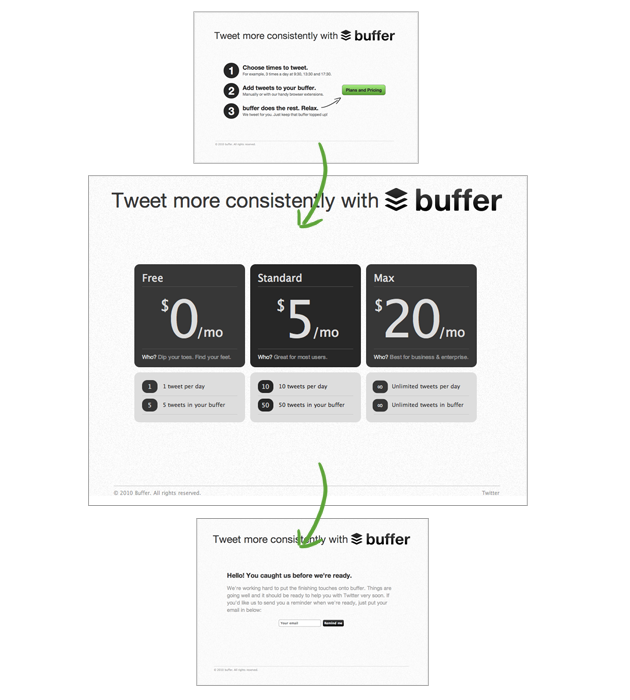I’ve been reading the book “The Lean Startup” by Eric Ries. It’s a book that’s built by a guy who’s a software engineer and has built IMVU – which was really popular during the IM age. In fact, I’ve tried creating an avatar in IMVU before although my laptop wasn’t able to accommodate the requirements.
In any case, I’ve learned a huge ton in his book (and I’m not even halfway!) he talks about the scientific approach to SaaS development. I’ve seen it work in Buffer’s case – they have an awesome story in their Building Buffer series. The first post is the most awesome of all – how they were able to generate revenue in 7 weeks! Crazy!
Here’s an excerpt to how they built a website that has nothing but the hypothetical MVP (Minimum Viable Product):
The smallest test
Here’s what we launched with:
The aim of this two-page MVP was to check whether people would even consider using the app. I simply tweeted the link and asked people what they thought of the idea. After a few people used it to give me their email and I got some useful feedback via email and Twitter, I considered it “validated”. In the words of Eric Ries, I had my first “validated learning” about customers. It was time to gain a little more validated learning.
Learning more
So we had validated that people probably wanted the product. The next thing to validate was whether people were comfortable with paying for such a product. This was as simple as adding a page in between the two which showed pricing. One extra click before they gave me their email for a notification when we launch. The extra step tests the pricing (by detecting which plan they click on) and also tests further the demand for the product (one extra click, so they must be keen). Here’s what we did:
The result of this experiment was that people were still clicking through and giving me their email and a small number of people were clicking on paid plans. After this result, I didn’t hesitate to start building the first minimal version of the real, functioning product.
Source: https://blog.bufferapp.com/idea-to-paying-customers-in-7-weeks-how-we-did-it
It was extremely awesome to read this. Double awesome that it came from Eric Ries’ book too! Apparrently (Founder of Buffer) is also a reader of Eric Ries and is an advocate of The Lean Startup book.
I have a handful of projects under my belt right now – one of them is a partnership where I’ve been given almost half equity. It’s a very interesting project (I don’t have permission to disclose information about it yet though). But it’s really exciting because it’s going to be the first of its kind. It’s also very scary.
Any ‘first of its kind’ product is a roll of the chance die – you just don’t know if it will work or not. My partner is very excited in building the product right away. While I was just as excited, I was very worried about the development cost and the ROI being a long-shot if we build it straight away.
So I showed him the Building Buffer series and asked him to read The Lean Startup book. I plan to do an MVP first to test our hypothesis. If it’s just me and him that wants to pay for our product, that doesn’t count. Our family and friends doesn’t count either (although they are a good start for validated learning). We need to let the idea out on the general public – target market or not – and then learn from their feedback.
I’ve never realized the scientific approach to SaaS development before but now I’m a huge fan and advocate of it. We didn’t really do this for Qeryz since it already has a supposed product/market fit from where we got the idea BUT we are developing some other parts of Qeryz that has never been shipped out before – completely new, innovative ideas on the on-page survey market.
It’s still under works but we’re going to be doing it under the scientific approach from now on.
Exciting times!









